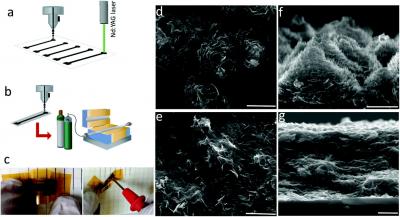Researchers at Iowa State University, along with collaborators at Rice University, Ames Laboratory and Lehigh University, have designed a new graphene printing technology that can produce electronic circuits that are low-cost, flexible, highly conductive and water repellent. The scientists explain that this technology could enable self-cleaning wearable/washable electronics that are resistant to stains, or ice and biofilm formation.

We’re taking low-cost, inkjet-printed graphene and tuning it with a laser to make functional materials, said authors of the paper. The work describes how the team used inkjet printing technology to create electric circuits on flexible materials. In this case, the ink is flakes of graphene. The printed flakes, however, aren’t highly conductive and have to be processed to remove non-conductive binders and weld the flakes together, boosting conductivity and making them useful for electronics or sensors. Such post-print processes typically involve heat or chemicals, but the research group developed a rapid-pulse laser process that treats the graphene without damaging the printing surface even if it’s paper.
One of the things we’d be interested in developing is anti-biofouling materials, said one of the paper's co-author. This could eliminate the buildup of biological materials on the surface that would inhibit the optimal performance of devices such as chemical or biological sensors.
The technology could also have applications in flexible electronics, washable sensors in textiles, microfluidic technologies, drag reduction, de-icing, electrochemical sensors and technology that uses graphene structures and electrical simulation to produce stem cells for nerve regeneration.
The researchers wrote that further studies should be done to better understand how the nano and microsurfaces of the printed graphene creates the water-repelling capabilities.
The Iowa State University Research Foundation is working to patent the technology and has optioned it to an Ames-based startup, NanoSpy, for possible commercialization. NanoSpy, located at the Iowa State University Research Park, is developing sensors to detect salmonella and other pathogens in food processing plants.



